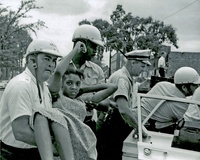Civil Rights in Chapel Hill, Photographs by Jim Wallace
Jim Wallace was one of several photographers on the ground during the civil rights struggle in Chapel Hill from 1961-1964, a movement led by local Black youth who attended the segregated Lincoln High School. A student at UNC at Chapel Hill, Jim was a photojournalist for the student newspaper, The Daily Tar Heel, which he describes as—at the time--particularly invested in calling out the injustice of segregation policies that prevented the as yet small number of Black students at UNC from walking across Franklin St. and sitting down to eat. Jim gained unprecedented access to the struggle. As you can see in these images, he was able to shoot from within the garage of the jail, from the second story of the building that housed the jail, and from inside police barricades. He credits this, on the one hand, to the Chief of the Police, William Blake, who was an avid reader of Gandhi and who Jim believed wanted an accurate picture of what was happening in Chapel Hill. On the other hand, Jim was a link between the Black leaders who sought media coverage (except for the DTH, little was forthcoming) and the police, who knew Jim knew where the next sit-in would be and followed him there. (See James Wallace, “Photojournalism and Its Role in Shaping and Preserving Local History,” Keynote for the MCJC Civil Rights in Chapel Hill Weekend, November 2012, and Hutchins Lecture, Center for the Study of the American South, https://vimeo.com/54381225).
How did the Jackson Center obtain these images? They were gifted to us by Jim in the process of developing his important book, Courage in the Moment: The Civil Rights Struggle 1961-1964 (2012), which features a selection of his photographs with text by Paul Dickson, former UNC student body president. The book itself has a story. As Jim was preparing for retirement from his 25-year role as Director/Curator of Imaging and Photographic Services at the Smithsonian Institution in Washington D.C., he revealed to his friend Lonnie Bunch, Director of the new National Museum of African American History, that he had a trove of images from his days covering the freedom movement in Chapel Hill. Mr. Bunch describes his encounter with Jim’s collection in the Foreword to Courage in the Moment:
"I had seen many of Jim’s photographs so I thought I knew much of his portfolio. I must admit that when he brought many of the images that comprise Courage in the Moment into my office, I was stunned. As Jim discussed each photograph I became more excited not only by the extraordinary visual quality of the images but also by their content. Before the meeting had ended I knew that many of these images needed to become part of the permanent collection of the museum. Fortunately for me, Jim agreed."
Bunch also encouraged Jim to pursue book publication. But Jim had a problem. While he could identify many of the police officers and white students in the photographs, he couldn’t do the same for most of the Black organizers and local participants. In 2010, he connected with the Jackson Center, which then held 2 open houses in the basement fellowship hall of St. Joseph C.M.E., at which civil rights leaders, and their families, children, and neighbors began to sift through the 100 or more photographs that covered several folding tables, putting names to faces. And then, as Jim recounts, “a very interesting thing happened”:
People--younger generations . . . who weren’t here or were too young to be part of the civil rights movement, were looking at my photographs on these card tables at St. Joseph’s and saying “I had always heard about this but I had never really seen it.” And then they would turn to some of the older parishioners who were there—because many of the marches started at St. Joseph’s—and they would go up to them and they would say “What did you do during the struggle?”
Answers to this question are relayed in the oral testimony of activists who grew up in historically Black Northside neighborhoods available on this site, particularly in the Chapel Hill Civil Rights Oral History Collection.
Jim’s photographs are important for many reasons, not the least of which is their power to spur critical conversation across generations. With rare intimacy, they reflect a movement uniquely led by teenagers who drew on principles of non-violent organizing and alliance to persist in courageous, escalating protest. They also reveal the intransigence of white supremacy in a town renowned as a liberal beacon within the South.
All photographs are included here with the direct permission of Jim Wallace.
























